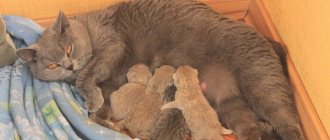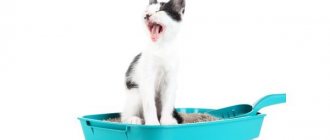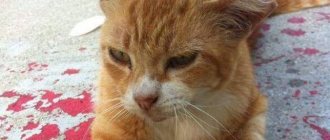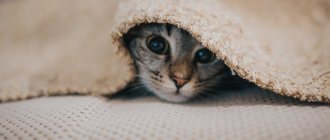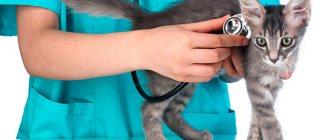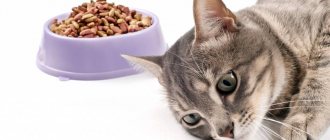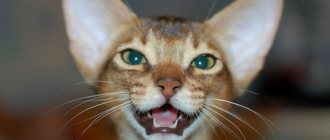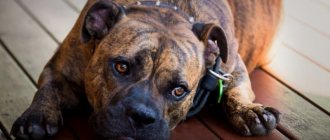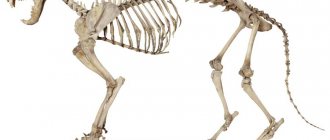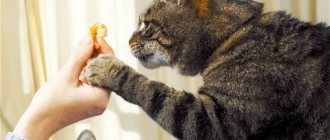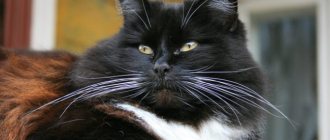What is fat tail?
The fat tail or primordial pouch is a small fold of skin on a cat's abdomen. It often sags by 3-5 cm. It is most noticeable in short-haired breeds.
When the cat moves, the fold sways from side to side. All cats have this structural feature.
In wild cats it is most pronounced. But in some domestic cats, the fat tail may not be visible to the eye.
Scientists have not yet come to a common conclusion about why cats need a primordial sac. However, they identified several theories explaining the functional purpose of the fat tail.
Protecting internal organs from injury
The stomach is one of the most vulnerable parts of a cat's body. Inside it are vital organs. But the abdomen is not protected by bones, like the sternum or skull. The fold of leather performs a protective function.
When hunting, cats move by hugging the ground. Obviously, the stomach becomes vulnerable to thorns and stones. Also, cats’ stomachs often suffer in fights for territory. Sharp claws easily tear through thin skin, causing serious injuries to the enemy. An additional layer of skin can protect internal organs from bites and cuts.
Nutrient supply
Often the fat tail is most pronounced in well-fed animals. It can also appear and disappear depending on the time of year.
A certain amount of fat accumulates in the skin fold, which is why it sags. And if the animal is starving, first of all the primordial sac decreases in size.
Sometimes predators have to starve for quite a long time. To survive periods of unsuccessful hunts, cats have to accumulate nutrients inside their bodies. The fat tail, in which adipose tissue is stored, is excellent for this purpose. In wild cats, it increases greatly in winter, when the animal eats up before the cold weather, but in summer, during the heat, it decreases.
The fat tail is associated with the movement patterns of cats
Cats' bodies are very flexible. During a hunt, all limbs are literally stretched and tense. When jumping, a cat can bend at a considerable angle. In order for an animal to be able to perform such tricks without hindrance, it needs not only flexible joints, but also elastic skin. Some scientists believe that the fat tail is needed so that the cat can more effectively use the flexibility of its body.
Signs of a pathological condition
The main pathological signs are a significant increase in the abdomen and the presence of hard formations. A fat belly is not a symptom, but an increase and thickening of this area can indicate a number of abnormalities. Among them:
- constipation;
- increased gas formation;
- disruption of the liver and kidneys;
- neoplasms;
- violation of the integrity of the bladder;
- problems with the digestive tract;
- inguinal hernia;
- in females the manifestation of mastitis, which can only be removed by surgical intervention;
- a dead fetus located in the uterus, which will also need to be removed through surgery.
Important!
If the owner of the animal notices abnormal behavior for his pet, loss of appetite or lumps in the abdomen, this becomes a reason to visit the veterinarian.
Reasons for appearance
So, all cats have a fat tail, but not all of them do, and it is not always visible visually. In long-haired breeds, the skin fold is hidden behind the long guard hair. Short-haired, thin animals also often show off their toned tummies. So why can a fold of leather sag so much?
There are several reasons why a cat develops a fat tail: 1. Genetic predisposition. There are some breeds in which the presence of a primordial sac is even specified in the breed standards. These are often breeds that are closely related to wild cats.
You might be interested in: Cat's skin is peeling: where to look for the cause?
2. Excess weight . In overweight cats, the fold of skin can be quite visually prominent. This is natural, because it is in it that fat is stored.
3. Pregnancy and childbirth. Often fat tail appears in pregnant cats. Often the abdomen increases significantly in size during multiple pregnancies, or when the fetuses are very large. Also, fat tail can appear immediately after birth in fit miniature cats. In a few days, the skin will tone and the stomach will tighten.
4. Dramatic weight loss. If an animal has lost a lot of weight, its abdominal skin may sag significantly. It takes time for the skin to tighten and the fat tail to become less noticeable.
5. Sterilization or castration. As a result of sterilization, serious hormonal changes begin in the animal's body. Often, a cat begins to eat a lot more, and its activity decreases, which is why it rapidly gains weight.
6. Old age. With age, skin tone decreases, which is why the lower abdomen can sag significantly. This is a natural phenomenon.
7. Illness. Diseases that can lead to fat tail enlargement are discussed below.
Dangerous symptoms
If a British, Scottish Sphynx or Pixie Bob has a loose underbelly, while the fat tail is stable in size, does not cause discomfort and looks like an integral part of the animal’s body, there is no need to worry about its appearance, since this is a physiological breed feature. However, when, in addition to the fact that the cat has a pouch hanging in the lower abdomen, there are pathological symptoms, the owner needs to take the pet to an appointment with the veterinarian as soon as possible. The following symptoms should alert you:
- rapid increase in abdominal size;
- edema formation;
- acute pain when pressed;
- change in skin color;
- decreased appetite;
- sudden weight loss;
- deterioration in general health.
Feature of the breed
There is a small list of breeds that are most prone to sagging primordial sac. Often, wild cats participated in the creation of these breeds, and they passed this feature on to their descendants.
List of breeds in which the fat tail is most often visually noticeable:
- Scottish Scottish Straight (straight ears)
- British
- Savannah
- Pixie bob
- Chausie
- Canadian Sphynx
- Cornish Rex
- Bengal cat
- Canaan cat
In direct descendants of wild cats (for example, in the Bengal breed), the fat tail is clearly visible from childhood. It may look a little strange on a flexible, toned body. But there is no reason to worry.
In the Scottish breed, the fat tail is not expressed in all lines. In the American line of Scottish cats, during selection, local aboriginal cats were used, in which the fat tail was not expressed. There is no such feature in cats of this line. But while working on the European line of Scots, a British breed was used, which passed on the pronounced fat tail to its descendants.
In the European line of Scots, the primordial fold is most often noticeable even in small kittens, which is a normal feature of the breed.
In almost all Canadian Sphynxes, the fat tail becomes very noticeable after castration. This is also a variant of the norm.
Prevention measures
What can you do to prevent this problem from occurring in your furry pet? To do this, the following preventive measures should be observed:
- divide the daily dose of food into several doses;
- provide round-the-clock free access to clean water;
- reduce the content of fiber and carbohydrates in the diet;
- competently transfer the kitten to adult complementary foods;
- Take your pet to the veterinarian regularly;
- promptly eliminate identified pathologies;
- periodically comb your furry pet;
- carry out deworming regularly.
When having a fat tail is not the norm
In most cases, slight sagging of the primordial sac is normal. But sometimes an enlarged abdomen and sagging skin may indicate symptoms of a disease.
Reasons why the belly can still increase significantly:
- Infection with worms. The abdomen may become very swollen due to severe parasitic infestation. In this case, worms affect not only the gastrointestinal tract, but also other organs. Their waste products lead to intoxication of the cat’s body. Body temperature rises and vomiting begins.
- Ascites. Due to disruption of the liver and kidneys, the stomach begins to increase in size. Dropsy forms. At the same time, the animal itself loses a lot of weight, which is why the body looks disproportionate. The cat is vomiting and diarrhea begins. The mucous membranes turn yellow. Breathing becomes heavy. Ascites is rather a symptom of some more serious disease.
- Intrauterine fetal death. If one of the kittens stops developing, its body may begin to decompose in the uterus. Intoxication occurs. Vomiting begins, body temperature rises, and there may be bloody discharge from the vagina. In this case, the abdomen seems hard to the touch, and you can feel the dead fetus.
- Constipation and intestinal obstruction. In this case, feces accumulate in the intestines. The animal behaves restlessly when trying to go to the toilet, and begins vomiting. Body temperature rises.
- Umbilical or inguinal hernia. Often appears as a result of complications after improper sterilization. It can also be a congenital feature, the result of injuries and other diseases. Small lesions form in the muscle and mucous tissues, through which the animal’s internal organs protrude. You can visually see a small tumor. It feels soft when pressed.
- Benign and malignant neoplasms. It is not uncommon for the abdomen to become very bloated with stomach and intestinal cancer. The animal loses weight very quickly. In the later stages, you can observe an unpleasant odor from the mouth, mucus and blood in the stool, vomiting, and increased body temperature.
- Mastitis in cats. Inflammation of the mammary glands occurs, causing them to swell and swell, pus may be released from the nipples; The cat's body temperature rises. In the absence of modern treatment, mastitis often leads to the development of cancer.
- Increased gas formation and bloating . Occurs due to disruption of the gastrointestinal tract.
- Bladder rupture. Urine begins to fill the abdominal cavity.
- Cushing's syndrome. Leads to disruption of the adrenal glands, which reduces the production of the hormone cortisol. The cat's abdominal volume increases greatly, the appetite increases, and at the same time the weight decreases, constant thirst appears, cramps, bones become more fragile.
- Pyometra in cats. As a result of poor-quality abdominal operations or other reasons, inflammation of the uterus occurs. Other symptoms: apathy, anxiety when touching the stomach, loss of appetite, persistent diarrhea.
- Infectious peritonitis. Often leads to ascites. Breathing problems occur, appetite decreases, convulsions occur, and coordination is impaired.
You might be interested in: Why does a lump appear near a cat’s nipple?
Most of these diseases require immediate medical attention. They are curable only in the first stages, and often lead to the death of the animal.
Symptoms that indicate that your cat needs to be seen by a doctor:
- constant licking of the belly;
- blueness or redness of the skin;
- hair loss on the abdomen;
- sudden weight loss;
- loss of appetite;
- the cat hisses, scratches and hides when someone tries to touch its belly;
- significant increase in body temperature;
- restlessness when trying to go to the toilet;
- diarrhea;
- difficulty breathing, convulsions;
- severe decrease in activity, apathy;
- frequent vomiting;
- Pregnant cats have frequent vomiting and bleeding from the vagina.
After castration, cats become fat and lazy
The most common myth about cats is that after castration they will definitely become fat, stop showing normal feline interest in life, and now they will only eat and sleep all the time. With all the confidence of the owner of castrati and neuters, I can say - nothing like that! After castration, the character of the animal does not change at all. Just imagine, they forgot to tell them that they were castrated, but they don’t even know, they live a cheerful, carefree life of an animal not concerned about sexual issues, and everything is fine with them. Naturally, immediately after the operation the animal will be depressed for 2-3 days and sleep more. But what about it? There was an operation with anesthesia! After the operation, people also don’t start dancing, but they lie in the hospital for some time. So a very big mistake of the owners is the attempt to impart human emotions to the state of the animal: “I castrated the cat, but now he doesn’t play and looks at me reproachfully that I’m so bad, I cut off his balls, deprived him of the joys of life...” and stuff like that. This is complete nonsense! The postoperative period will pass, the anesthesia will wear off and the cat, as if nothing had happened, will again run and jump as before. Just stop toiling from dissatisfaction. Many owners notice that from the gloomy-sad bridal barker, the cat after castration seems to return to childhood, remembers how he frolicked as a kitten, and begins to notice how many interesting things are around.
With all the confidence of the owner of castrati and neuters, I can say - nothing like that! After castration, the character of the animal does not change at all. Just imagine, they forgot to tell them that they were castrated, but they don’t even know, they live a cheerful, carefree life of an animal not concerned about sexual issues, and everything is fine with them. Naturally, immediately after the operation the animal will be depressed for 2-3 days and sleep more. But what about it? There was an operation with anesthesia! After the operation, people also don’t start dancing, but they lie in the hospital for some time. So a very big mistake of the owners is the attempt to impart human emotions to the state of the animal: “I castrated the cat, but now he doesn’t play and looks at me reproachfully that I’m so bad, I cut off his balls, deprived him of the joys of life...” and stuff like that. This is complete nonsense! The postoperative period will pass, the anesthesia will wear off and the cat, as if nothing had happened, will again run and jump as before. Just stop toiling from dissatisfaction. Many owners notice that from the gloomy-sad bridal barker, the cat after castration seems to return to childhood, remembers how he frolicked as a kitten, and begins to notice how many interesting things are around.
As for thickness, everything is somewhat more complicated. The eternally skinny, anxious cat BEFORE, among other joys of life, begins to eat with appetite again and very quickly rounds up AFTER. In the good sense of the word, I want to say, it stops “rattling its bones” :)) And this speed with which it eats away right before our eyes scares the owners. The second big mistake they make, fearing that the cat will gain too much weight, is to begin to limit his food. Under no circumstances should this be done! The cat is deprived of food when he has no appetite, he begins to be afraid that he will starve and begins to eat more than necessary for use, as a result he gains more weight, he is even more restricted, etc. - as a result, a vicious circle is created with an eternally hungry fat cat and an owner who is always preoccupied with diets. Don't let this happen! If before castration food was always freely available, it should also remain after castration. It is necessary to switch the cat to a food with less calories, gradually replacing the old food with a new one, but not reducing the amount. This way you will reduce the number of calories, but the animal will not be afraid of hunger and will eat without overeating. And such a life will be easier for you than constantly worrying about how the cat might overeat. I never put my neutered dogs on a special diet; they live and eat together with non-castrated male and female cats. And they are never overly fat and lazy. Another thing is that there are cats that tend to be overweight. Well, even before castration they are not thin and they need to be kept on a diet constantly, so life will not change for them either.
The eternally skinny, anxious cat BEFORE, among other joys of life, begins to eat with appetite again and very quickly rounds up AFTER. In the good sense of the word, I want to say, it stops “rattling its bones” :)) And this speed with which it eats away right before our eyes scares the owners. The second big mistake they make, fearing that the cat will gain too much weight, is to begin to limit his food. Under no circumstances should this be done! The cat is deprived of food when he has no appetite, he begins to be afraid that he will starve and begins to eat more than necessary for use, as a result he gains more weight, he is even more restricted, etc. - as a result, a vicious circle is created with an eternally hungry fat cat and an owner who is always preoccupied with diets. Don't let this happen! If before castration food was always freely available, it should also remain after castration. It is necessary to switch the cat to a food with less calories, gradually replacing the old food with a new one, but not reducing the amount. This way you will reduce the number of calories, but the animal will not be afraid of hunger and will eat without overeating. And such a life will be easier for you than constantly worrying about how the cat might overeat. I never put my neutered dogs on a special diet; they live and eat together with non-castrated male and female cats. And they are never overly fat and lazy. Another thing is that there are cats that tend to be overweight. Well, even before castration they are not thin and they need to be kept on a diet constantly, so life will not change for them either.
Diagnostics
If any changes in your pet's appearance or behavior seem strange, it is best to take your pet to the doctor for a routine examination. First of all, the doctor feels the skin fold. There should be no seals in it. The animal should not experience pain. The cat will need to be weighed. If the doctor finds any signs of an animal’s disease, he will have to conduct a full diagnosis. Tests that need to be taken to detect the cause of the disease:
- general blood analysis;
- urine and feces to detect parasitic infestation;
- Ultrasound;
- X-ray;
- biopsy.
Based on the results obtained, the doctor will conclude whether there are reasons for concern. The veterinarian will also prescribe a course of treatment.
Why do cats lie on their owners' things?
Many people have probably noticed that as soon as you take off something and don’t immediately put it in the closet, the cat comes and lies down on it. Cats do the same thing with a stack of freshly ironed laundry, which terribly annoys housewives. Why do cats do this, they think, are they really being deliberately mischievous, knowing how angry it makes them? In fact, everything is much simpler - the cat does not like foreign odors in the house where it lives. Her house smells like herself :) so she carefully “mixes” someone else’s smell with her own. This is why the cat comes running and begins to actively rub against the new thing that was just brought. She actively participates in the unpacking, diligently sniffing it from all sides and rubbing against all corners.
Treatment
So, all cats have a primordial sac. If it sags by about 3-5 cm, this is considered normal. If there are no other symptoms of the animal's disease, there is no need to worry.
It is necessary to take action only if the total weight of the pet significantly exceeds the norm. You should weigh your pet and compare the data with the height and weight standards established for this breed.
You can also determine obesity yourself: you need to look at the cat from above, and then feel its sides. When palpating, the ribs should be palpable, and the stomach should not stick out to the sides.
You may be interested in: Urolithiasis in cats: causes and symptoms of the disease, treatment of pathology
Obesity negatively affects the functioning of all internal organs of the animal. It can lead to a number of dangerous diseases. Therefore, an animal that has been diagnosed with obesity needs to be put on a diet.
In this case, special low-calorie foods are perfect. In addition, be sure to follow the portion size indicated on the package of food.
You should not feed the animal on demand. It is imperative to follow the feeding schedule.
You should also keep the animal on a diet immediately after sterilization. Due to hormonal imbalances, cats often begin to eat a lot, which is why their weight rapidly increases.
Increasing physical activity is also helpful for weight loss. You need to play with the cat more. If all required vaccinations have been completed, the animal can be taken outside on a leash.
If any disease has caused the enlargement of the primordial sac, the doctor may use conservative or surgical treatment methods. In some cases, the animal will have to be transferred to a hospital.
How to make a British cat's cheeks bigger?
The round, well-developed cheeks on the face of a British cat are one of the main distinguishing features of the breed. It is not surprising that every owner of a British dog dreams that his handsome man has wow cheeks! And they get very upset if the cheeks are very small. Rumors persistently circulate among people that you can “eat” your cheeks; you just need to know what, even all sorts of recipes are offered. I have to disappoint you, dear readers, - the presence/absence of expressive cheeks is purely genetic, just like the length of the tail, the strength of the bones or the texture of the coat. You either have cheeks or you don’t, and there is no diet that can make them bigger! Remember how in the old fairy tale about Cinderella? “No connections will help you make your legs small, your soul big, and your heart fair” E. Schwartz
